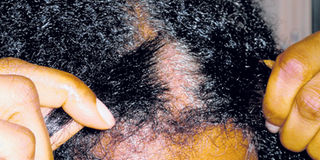THE PHARMACIST : What's causing those flakes?

A woman itching her scalp that has traces of dandruff ,one of the most uncomfortable side effects.PHOTO|FILE
What you need to know:
- The good news is that you may not need a prescription of shampoo or a trip to the dermatologist to treat mild forms of dandruff. You may even find worthwhile solutions in your grocery store or in your own home.
It’s embarrassing and uncomfortable — an itchy scalp that leaves your shoulders dusted with flakes. Dandruff affects an estimated 50 per cent of the population and pharmacies are filled with products that promise relief.
The good news is that you may not need a prescription of shampoo or a trip to the dermatologist to treat mild forms of dandruff. You may even find worthwhile solutions in your grocery store or in your own home.
Dandruff is characterised by flakes and can be caused by a number of things. Dry skin is commonly blamed for skin flakes, but some forms of dandruff come from overactive oil glands. Eczema, psoriasis, allergic reactions, and a fungus called malassezia are also causes of dandruff.
The best treatment for your condition depends largely on the cause. Once you’ve determined why you have flakes, you can look at possible solutions. When it comes to dandruff, most people focus on the flakes. Itching, on the other hand, may be the most uncomfortable side effect.
Symptoms and causes
Flakes and an itchy, scaly scalp are the main symptoms of dandruff.
White, oily flakes typically accumulate in your hair and on your shoulders. The following could be reasons for a scaly itchy scalp:
• Irritated and oily skin, a condition known as seborrheic dermatitis.
• Not shampooing enough, which causes skin cells to accumulate and create flakes and itching.
• Yeast called malassezia, which aggravate your scalp and cause excess skin cell growth
• Different personal care products may cause contact dermatitis, which makes your scalp red and itchy.
Possible solutions
• Using the right shampoo:
If your scalp is itchy, you may be able to get some relief by using over-the-counter (OTC) shampoos that are formulated to help with dandruff. Getting the right fit may take some trial and error, so if you haven’t had luck in the past, try again. Sometimes alternating two or more shampoo types can also help.
• Moisturise:
A dry scalp tends to flake and itch, but usually the flakes you’ll experience with dry skin are smaller and less oily. Restoring moisture to the scalp can help with itchiness, and the best moisturiser might already be sitting on your kitchen shelf. Coconut oil has moisturising and antibacterial properties, making it a great, natural choice for fighting dryness.
• Good hygiene:
Shampooing often enough can keep oils at bay, helping with dandruff symptoms. While you are at it, try to resist the urge to scratch your scalp. The itchiness is initially caused by irritation from dandruff, but scratching will increase irritation and lead to a vicious cycle.
• Relaxation:
Stress can aggravate or even worsen dandruff for some individuals. While malassezia is not introduced to your scalp by stress, it can thrive if your immune system is compromised, which is exactly what stress does to your body. Do your scalp a favour and relax. Try walking or practicing yoga. You may even find it helpful to keep a log of stressful events. Write down what they are and how they impact your dandruff. That way, you can do your best to avoid potential triggers in the future.
Skin cells that grow and die off too fast are the problem. Exactly why that happens isn’t clear, medical sources show.
But there is one theory which shows that the immune system of someone with dandruff may overreact to that fungus.
One common cause is what is known as seborrheic dermatitis, or seborrhea. Some people with dandruff may also have seborrheic dermatitis in other areas of the body, such as their ears, the center of the face, and the center of the chest.




